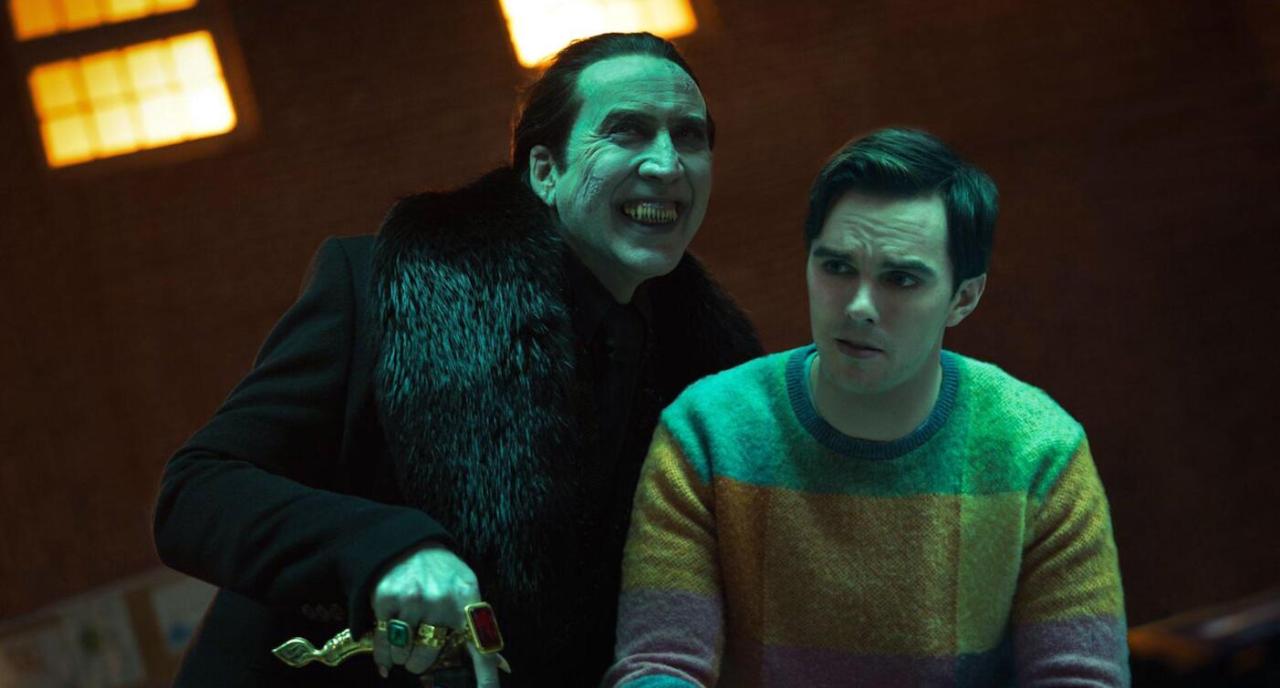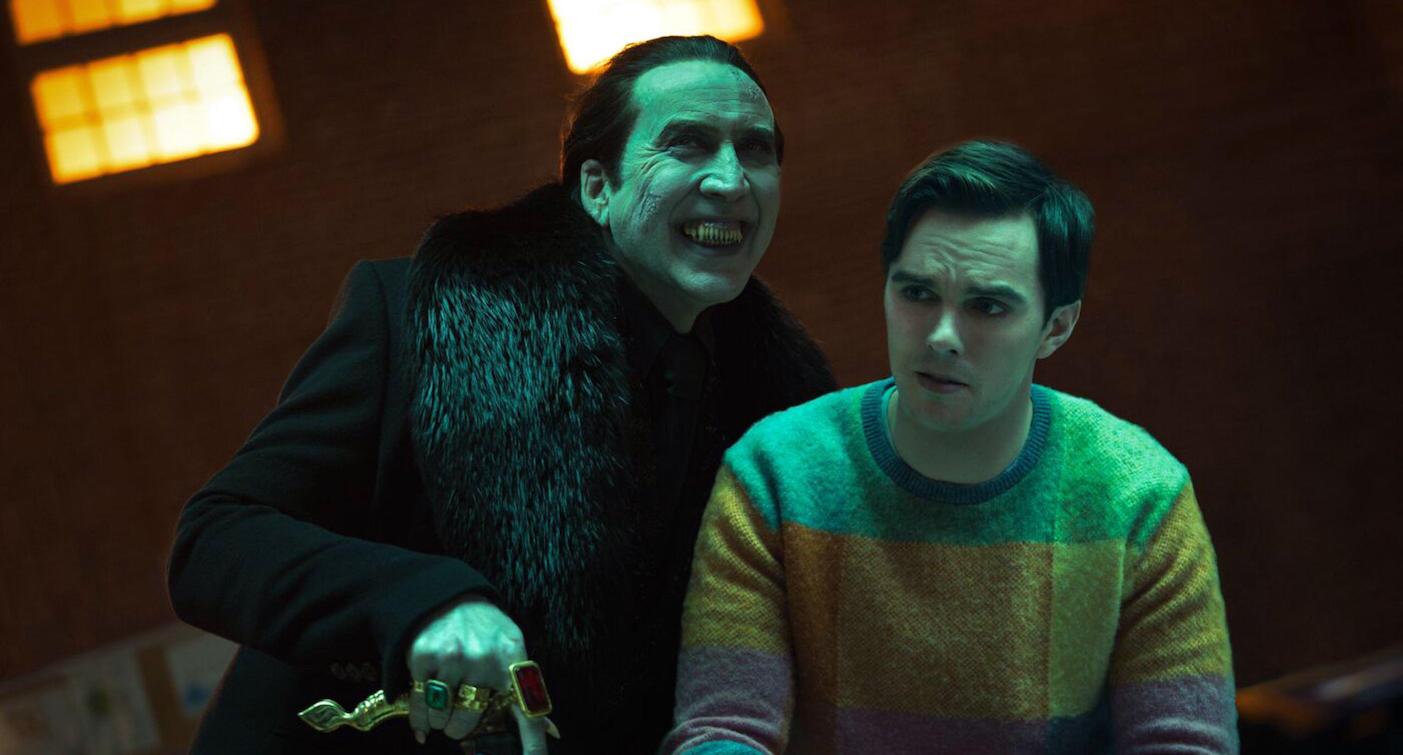If Dracula is about anything, he’s about sex. Renfield, in theatres now, is the latest revamp of the Transylvanian bloodsucker mythos, and it is not about sex. In fact, it is a thoroughly sexless movie which might be why, despite some gusto performances and gloriously icky make-up effects, Renfield is a flaccid, directionless affair.
There is an early red flag that signals where the movie is going. Nicholas Hoult as the titular minion and Nicolas Cage, playing fiction’s most feared set of fangs, are laying low in an abandoned hospital in New Orleans, having fled there after a nasty run-in with some vampire hunters in the old country. Famished for fresh blood, Dracula demands that Renfield bring him ‘a busload of cheerleaders’. ‘Female cheerleaders?’ Renfield queries, with a cynical inflection. ‘Don’t make it a sexual thing,’ Dracula snaps. It is bloodlust, not libido, that drives him.
There is no passion, devilish or otherwise, in Renfield
In Renfield, a horror comedy directed by Chris McKay, Dracula the throat-gashing seductor of 19th-century maidens is reinterpreted as the boss from hell. So much so that Renfield, the bug-munching servant who supplies his master with innocents to feed on, pines for a normal, non-evil life. Letting this slip to Dracula enrages the egomaniacal exsanguinator, who hisses: ‘My needs are the only thing that matter.’
Renfield has been secretly attending group therapy for those stuck in co-dependency relationships, a crutch that finally convinces him to walk away and start a new life, complete with hideous pastel jumpers and an apartment decorated with framed affirmations. (‘I am enough. I deserve happiness.’) When Dracula learns of this, he confronts Renfield and echoes every cliché from domestic abusers, fully convinced that it is Renfield who needs Dracula, not the other way around.
This is all wrong. Dracula is not about escaping from toxic relationships and healing through self-care and affirmations. It is a dark, chilling tale of blood and sex and power, or at least that is what the Hollywood rendering of the story has been. Dracula is a nobleman predator whose aberrant appetites terrify us even as we draw nearer for a closer look. We do so because the Dracula story is about the two subjects that discomfit and compel us most, sex and death. Dracula is a true antichrist, offering us eternal living-death in exchange for sin.
One of the earliest silver screen portrayals was Bela Lugosi in Dracula (Tod Browning, 1931), whom film historian John Oliver credits with ‘imbu[ing] the Count with a hitherto absent sexual quality’, rendering the Transylvanian terror ‘a suave seducer, and the vampire’s bite a sensual act’. So sensual that, when he comes to bite Mina (Helen Chandler) in Browning’s movie, the penetration, as it were, takes place off-screen. We see the Count enter through her bedroom window, lurk in her chamber in menacing chiaroscuro, then creep his way towards the sleeping damsel, before obscuring the act in a whip of his cape.
Fast-forward almost four decades and Dracula Has Risen from the Grave (Freddie Francis, 1968) is more explicitly sexual. The brooding blood-sucker appears at dusk outside the bedroom of Maria Mueller (Veronica Carlson), the niece of a priestly foe. Dracula (Christopher Lee) transfixes her with a hypnotic stare until Maria sprawls across her bed, her bosoms heaving and her eyes pleading, and allows the vampire to caress her lips with his before a lingering, subjective camera brings his fangs towards her jugular.
The eroticism of Dracula’s bite is seldom more brazen than in Dracula (John Badham, 1979). Here the undead smoothie, a carnal and moody Frank Langella, seduces Lucy Seward (Kate Nelligan) and the pair consummate in one of the most sexualised scenes of blood-letting a Dracula flick has ever provided. Their bodies interlock in silhouetted abandon as the screen roils with scarlet psychedelic visuals, like some trippy gothic arthouse porno.
Although, as Oliver notes, it was the movies that turned Dracula into a sinister sex symbol, there are slivers of sensuality in Bram Stoker’s characterisation. The 1897 novel describes the Count’s feasting on Mina, fiancee of Jonathan Harker, in fleshly terms:
[H]is right hand gripped her by the back of the neck, forcing her face down on his bosom. Her white nightdress was smeared with blood, and a thin stream trickled down the man’s bare breast which was shown by his torn-open dress… His eyes flamed red with devilish passion…
There is no passion, devilish or otherwise, in Renfield. When Renfield turns on his master, the movie turns him into a superhero, teaming him up with a maverick cop, Rebecca (Awkwafina), to take on a corrupt police force and the crime family that murdered her father. It’s a blatant attempt to smuggle the character into the archetype of the tortured-soul antihero, the reformed villain who seeks redemption in fighting evil. That’s the kind of character you can hang a franchise on and franchises are the only thing Hollywood is interested in now.
Perhaps this arc will find an audience. It reflects contemporary mores about victimhood, toxic relationships, and the transcendent importance of the self. But in over-intellectualising Stoker’s source material, Renfield loses what is scary about Dracula and what is funny about his deranged aide de camp. Sucking more life (and box office revenue) out of characters we’ve seen played everywhere is tired and unoriginal, especially if you insist on making Dracula a sexless supervillain with a generic plot to take over the world. Dracula is about a much more intimate form of domination and maybe that aspect of the character is just too problematic in 2023 to dramatise without layering on social commentary.
Where Renfield goes wrong is in its premise. Screenwriters Ryan Ridley and Robert Kirkman should have left the Count in his coffin and injected some fresh blood into the long tradition of cinematic vampirism. The vampire plot can fit neatly into the superhero action genre, as seen in Blade (Stephen Norrington, 1998) and Underworld (Len Wiseman, 2003). Vampires and those drawn to them are ideal characters to explore themes of isolation and the outcast’s longing and contempt for normality. Think Near Dark (Kathryn Bigelow, 1987) and Let the Right One In (Tomas Alfredson, 2008).
If it’s comedy you’re after, a contemporary vampire tale stands more chance of mining wit or satire than another try at goofing up the Dracula plot. Compare The Lost Boys (Joel Schumacher, 1987) and Fright Night (Tom Holland, 1985) with Dracula: Dead and Loving It (Mel Brooks, 1995) and Love at First Bite (Stan Dragoti, 1979). Or if you want to make a movie about a boss who creates a hostile work environment for his underlings, there’s Vampire’s Kiss (Robert Bierman, 1988), in which a publishing executive gets bitten, is convinced he is turning into a vampire, and becomes a proto Patrick Bateman. (The executive is played, incidentally, by Nicolas Cage.)
In telling stories unfettered from Bram Stoker’s well-explored mythology, these movies do some or all that Renfield aspires to do but can’t because of its ambivalence towards that mythology. The movie invests so much in Dracula only to denude him of his predacious passions and then dumps him in favour of yet another 90 minutes of kick-ass, power-stride, we-got-this superheroing. Renfield not only takes the sex out of Dracula, it takes the Dracula out too.







Comments